Content
The most dangerous parasites of farm animals are tapeworms or tapeworms. They are not dangerous because they cause economic damage to livestock. Infected animals practically do not suffer from these types of worms. A person suffers from them, as the ultimate host of the parasite. The larvae of one of the tapeworm species cause finnosis in cattle and the subsequent infection of a person with a long-lived worm up to 10 m long and a life expectancy of 10 years. But with the help of a bovine tapeworm it is good to lose weight. You can eat anything and as much as you want. But this, of course, is sarcasm.
What is bovine cysticercosis
A more correct name for cattle finnosis is cysticercosis. But Finnos is easier to pronounce and remember.
The "founders" of cysticercosis are tapeworms of various species from the genus Tenia, they are also Cystodes. These parasites are most common in relatively warm regions:
- Africa;
- The Philippines;
- Latin America;
- Eastern Europe.
But you can find them in Russia as well. Especially taking into account the widespread import of elite cattle breeds from Western countries to the Russian Federation.
Cattle is infected not by the helminths themselves, but by their larvae, which even have their own Latin name: personal for each species. Therefore, in fact, bovine cysticercosis is infection of cattle with bovine tapeworm larvae.
In cattle, larvae of other types of tapeworms can also be found, but their localization differs from the location of bovine cysticercus.
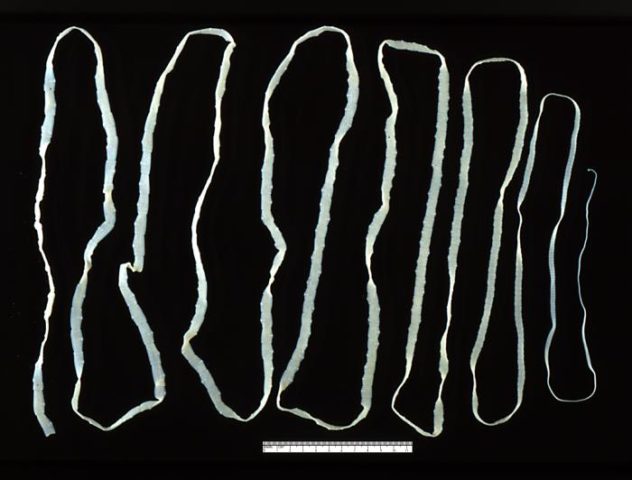
This is not a ribbon, but the "culprit" of cattle finnoses - a bull tapeworm, the length of which is 10 m. Head on the right
Tapeworm life cycle and infection of cattle with finnosis
An adult parasite can live only in the small part of the human intestine. With its mouth, the worm sticks to the mucous membrane and grows, gaining a length of 2-5 thousand segments. If the tapeworm has settled in a person, it is very difficult to drive him out. When using anthelmintic drugs, the parasite sheds its segments, but the head remains attached to the wall of the small intestine. From the head the tapeworm begins to grow again. It is, of course, possible to "finish off" the worm with potent drugs. But if you do not take any measures, then according to various sources, its life in the intestine can be from 10 to 20 years. The tapeworm produces up to 600 million eggs annually.
Oncospheres enter the external environment with human excrement. So in medicine and veterinary medicine tapeworm eggs are called.
In the intestine, the worm discards mature segments filled with eggs. These "capsules" and "pass" along the gastrointestinal tract the rest of the way. Cattle becomes infected with oncospheres by eating contaminated feed.
Through the intestinal wall, oncospheres penetrate into the blood, which carries them throughout the body. But further development of the larvae takes place in the muscles. There, oncospheres turn into cysticercus, causing finnosis / cysticercosis in cattle. The parasite does not do much harm to its intermediate host, patiently waiting for the herbivore to get to the predator for lunch. Or a person.
Human infection occurs when eating poorly processed heat-treated meat. And the life cycle of a tapeworm starts over. Comment! In humans, this invasive disease is called teniarinchiasis.
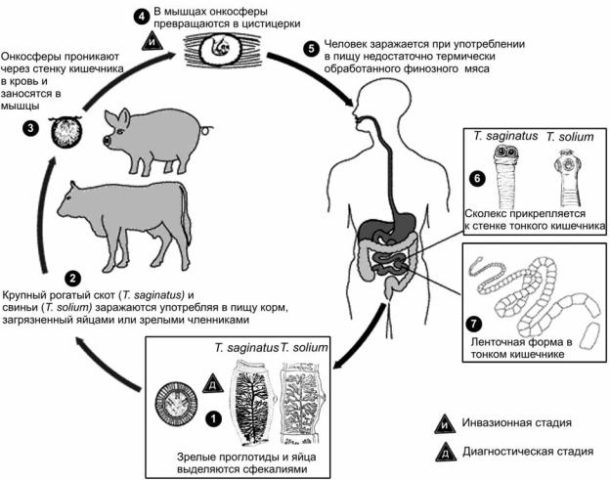
The life cycle of a bovine tapeworm, including cattle finnosis and human teniarinhoses
Types of cattle finnoses
Strictly speaking, there is only one species of cattle finnosis: the one caused by Cysticercus bovis, the larva of Taeniarhynchus saginatus / Taenia saginata (in this case, the Latin names are synonyms). And in a simple way: in cattle, finnosis is caused by the larva of a bovine tapeworm. Although, given the ultimate host of this parasite, it would be more correct to call the worm "human".
But cysticercosis, which cattle can suffer from, is not limited to finnosis. Somewhat less frequently, but cattle can also become infected with other tapeworms. The ultimate hosts of the tapeworm of the species Taenia hydatigena are carnivores, to which humans can rightfully be attributed today. In nature, scavengers become infected by eating the carcass of a fallen, invaded animal. A person can get a lodger if he uses the internal organs of farm animals.
Just like the bovine tapeworm, the tapeworm of carnivores "sows" the segments into the environment. Herbivores, eating food contaminated with the excrement of predators, become infected with tenuicol cysticercosis. Animals susceptible to infection with this type of cysticercosis:
- sheeps;
- goats;
- pigs;
- Cattle;
- other herbivores, including wild species.
Once in the intestine, oncospheres with blood migrate to the liver, drill the parenchyma and enter the abdominal cavity. There, after 1-2 months, the oncospheres turn into invasive cysticercus.
Tenuicol cysticercosis differs from cattle finnosis in that it is widespread almost everywhere. It does not have areas of maximum spread, like the Finnoza. It helps only that cattle are infected with tenuicol cysticercosis less often than with finnosis.
Another type of cysticercosis - "cellulose", also called finnosis. But Taeniasolium larvae do not parasitize in cattle. They amaze:
- cats;
- bears;
- pigs;
- dogs;
- camels;
- rabbits;
- person.
Cysticercosis caused by Cysticercus cellulosae is also called porcine finnosis. A man for a pork tapeworm is both an intermediate and a final owner. If we get lucky".
They just call these diseases differently. And the intermediate owners of other cestodes are different.
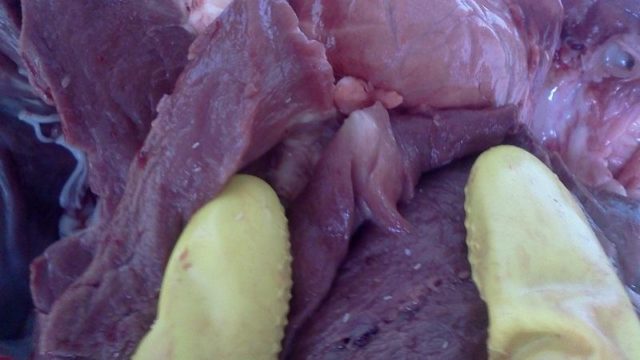
If you carefully cut carcasses of cattle infected with finnosis, you can see cysticercus. These are white spots in the photo.
Symptoms of cow finnoses
The manifestation of clinical signs of cysticercosis depends on the degree of infection. If it is mild, the animal may not show symptoms at all. With a strong infection of cattle with cysticercosis, the following is observed:
- increased body temperature;
- weakness;
- muscle tremors;
- oppression;
- lack of appetite;
- rapid breathing;
- intestinal atony;
- diarrhea;
- groans.
These signs last for the first 2 weeks, while the larvae from the intestine migrate to the muscles. Then the symptoms of finnosis disappear, the animal “recovers”. The owner is glad that everything worked out.
Signs of infection with cysticercosis tenuicolum are noticeable only during the acute course of the disease, while the larvae migrate through the liver to the site of localization:
- heat;
- refusal of feed;
- rapid heartbeat and breathing;
- anxiety;
- icteric mucous membranes;
- anemia;
- diarrhea.
With a strong infection with tenuicol cysticercosis, young animals may die within 1-2 weeks. Further, the disease goes into a chronic stage and proceeds with uncharacteristic signs or asymptomatic.
Diagnosis of cysticercosis in cattle
Lifetime diagnosis of cysticercosis in cattle is made using immunological methods. But it is possible to determine exactly what type of cysticercosis hurts an animal only posthumously.
The diagnosis is usually made only after the animal has been slaughtered. With cysticercosis of cattle, the localization of the larvae occurs in the striated muscles. In a simple way, in the same beef that comes on the table in the form of steaks, entrecote and other goodies.True, you have to be very careless to start cooking this meat. If cattle is infected with cysticercosis, it is not necessary to examine the meat under a microscope: the diameter of the bubbles located between the muscle fibers is 5-9 mm.
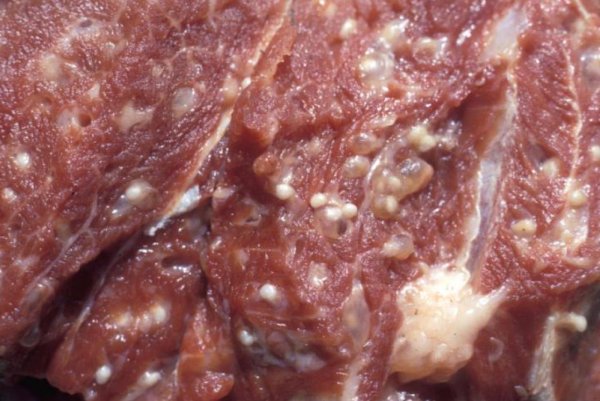
This is what the meat of an animal infected with bovine cysticercosis looks like in the photo.
They are clearly visible to the naked eye. But you can play a naturalist, take a microscope and admire the double shell and one scolex of cysticercus, which causes cattle finnosis.
When infected with cysticercus, the carnivorous Taenia hydatigena worm larvae are even more difficult to miss. Cysticercus tenuicollis are localized in internal cavities and organs and are about the size of a hen's egg. And if you want, you won't miss it.
In the acute course of cysticercosis tenuikolny in the dead young animals, changes in the internal organs are found:
- an enlarged liver is clay-colored;
- on the surface of the liver there are punctate hemorrhages and tortuous bloody passages in the parenchyma;
- in the abdominal cavity there is a bloody fluid in which fibrin and small translucent white bubbles float.
These vesicles are the migrating cysticercus of the tapeworm of carnivores. When washing the crushed liver, young larvae are also found.
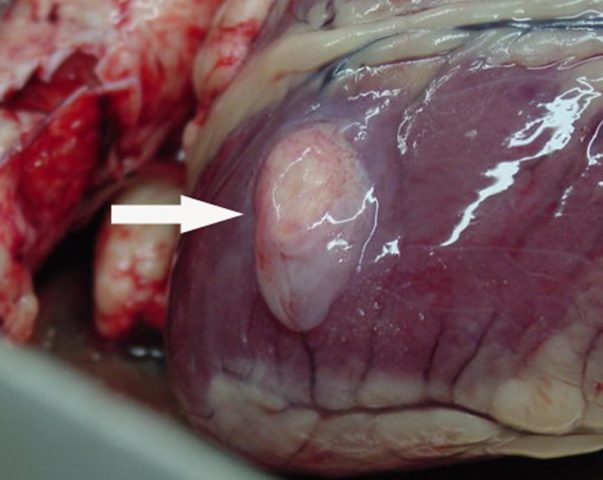
Cysticercus tenuicollis in the heart muscle
Treatment of cysticercosis in cattle
Until recently, all reference books indicated that the treatment of finnoses has not been developed, since the larvae in cysticercus (capsule-spheres) are well protected from the action of anthelmintic drugs. Sick cattle are slaughtered and the meat is sent for deep processing. I mean, they make meat and bone meal from carcasses, which is then used for fertilizers and animal feed.
Today, cattle finnosis is treated with praziquantel. The dosage is 50 mg / kg body weight. Administer praziquantel for 2 days. The drug can be punctured or added to the feed. The manufacturer of the drug is the German company Bayer. But it should be borne in mind that complete confidence in the cure of an animal from cattle finnoses can be obtained only after the slaughter and examination of cysticercus under a microscope (alive or dead).
However, for the owner of dairy cattle, only the acute stage of cattle finnosis, when the larvae migrate into the muscles, is dangerous. At this time, cysticercus can also enter the milk ducts. Later, it will be impossible to get infected through milk.
Preventive actions
Prevention of bovine cysticercosis has to be carried out not only in the farm where the infection was detected, but also in the entire area. Slaughter of animals at home is prohibited. All cattle meat that comes from farms and from settlements in the contaminated area is carefully monitored. Restrict the movement of stray animals. Simply put, stray dogs are shot, and the owners are required to be put on a chain.
Animals sent for slaughter are tagged with tags in order to find out the foci of infection with Finnosis and to identify people sick with teniarinhoses. Carcasses infected with cysticercosis are neutralized following veterinary and sanitary rules.
Farm personnel are quarterly examined for infection with teniarinhoses. People who are found to have tapeworm are banned from serving animals.
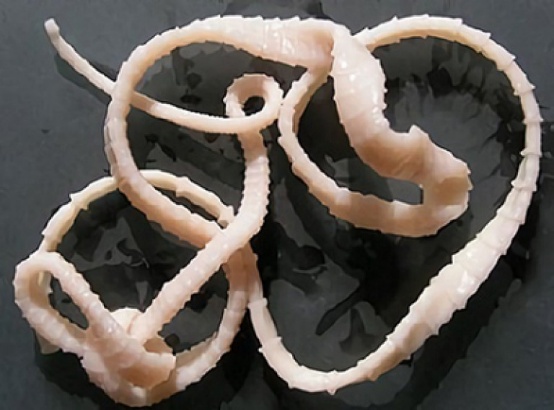
Unfried meat of an animal sick with Finnosis is the source of the appearance of this cute pink worm in the human gastrointestinal tract.
Threat to humans
Trapped along with uncooked cattle meat into the human body, the cysticercus quickly turns into a young tapeworm. The worm grows and after 3 months it begins to shed ripe segments.
It is "unprofitable" for the parasite to be quickly detected, and the most common sign of infection with teniarinchiasis is the isolation of these very segments. "Capsules" can appear as separate organisms, as they partially show signs of small flatworms: they crawl. The patient also feels itching in the anus.
Due to the fact that the beast is already large inside, the patient may experience:
- nausea and urge to vomit;
- bouts of abdominal pain;
- increased appetite with weight loss;
- sometimes the appetite decreases;
- weakness;
- digestive disorders: diarrhea or constipation.
Signs of allergies are sometimes noted. Few people associate other signs with helminthic invasion:
- nosebleed;
- dyspnea;
- palpitations;
- noise in ears;
- flickering blackheads before the eyes;
- discomfort in the region of the heart.
With multiple infection with bovine tapeworm, dynamic intestinal obstruction, cholecystitis, internal abscesses, appendicitis are noted.
The discarded segments, showing fair mobility, can get through the Eustachian tube into the middle ear or into the respiratory tract. To do this, they first need to get into the oral cavity, which they do, excreting with vomit.
In pregnant women infected with bovine tapeworm, the following are possible:
- spontaneous abortion;
- anemia;
- toxicosis;
- premature birth.
Here is such a "cute and very useful for losing weight" worm can start in a person:
Conclusion
Finnosis in cattle is not so dangerous for the animals themselves as for humans. It is almost impossible to remove larvae from muscle fibers. Even after the application of praziquantel and the death of the larvae, the spheres themselves will remain in the muscles.








